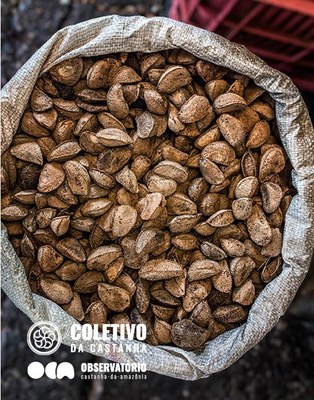OCA coordinates strategy of prices monitoring to inform Brazil nuts collectors in the forest
The Brazil nuts value chain has been historically characterized by a degree of informality and management weakness. Its potential has attracted several projects aimed at improving traditional practices and training Indigenous, riverine and quilombola communities in the Amazon.
One of the obstacles in this process is related to pricing policies. The Amazon Nut Observatory (OCA, in the Portuguese acronym) enhanced a participatory price monitoring system to assist Brazil nut collectors.
The Observatory is a network of organizations that work to develop the Brazil nuts value chain, producing knowledge and mobilizing actors to consolidate a fair market aimed at conserving the forest and valuing people and communities involved.
Three PCAB implementing partners are part of OCA: the Brazilian Education Institute (IEB), the Ecological Research Institute (IPÊ) and the United States Forest Service (USFS). Other members are Imaflora, the Water Pact (PACTO), the Native Amazon Operation (OPAN), the Vale do Amanhecer Settlement Cooperative (COOPAVAM), the Vitória Amazônica Foundation (FVA), WWF-Brasil, Conexsus, the Socio Environmental Institute (ISA), the Protected Forest Association (AFP - an Indigenous Kayapó Association), Embrapa (the Agricultural Research Federal Agency), the National Council of Extractive Populations (CNS), and the Chico Mendes Memorial (MCM). OCA is funded by USAID/Brazil and the Climate and Land Use Alliance.
“At the beginning of the harvest, in October and November, we started mobilizing participants and collecting prices directly from Brazil nut gatherers. Our group already includes around 100 people from seven states. They are family farmers, and members of quilombola, riverine, and Indigenous communities,” says Julianna Maroccolo, head of Participatory Price Monitoring at the OCA Nut Collective.
Julianna recalls that price monitoring has been carried out since 2018 by a collective of Brazil nut producers across the Amazon, who communicate via a WhatsApp group. However, OCA can help to strengthen this stage of the production chain, and improve the data collected.
“We are constantly learning and trying to improve. We still need, for example, to better contextualize our sources of information so that we can understand why prices differ from one region to another. But for the first time, we have important strategic pricing information. With this, in addition to providing Brazil nuts collectors with information and knowledge to support their decision-making, we intend to influence and improve public policies to benefit the whole chain, in particular local producers and community organizations,” explains Julianna.
Brazil nuts are one of the products included in the Minimum Price Policy for Sociobiodiversity Products (PGPM-Bio), managed by the National Supply Company (CONAB). In recent years, it gained importance in the market, and occupies the second place (after açaí) in the ranking of the main non-timber products in the Amazon region.
It is considered an important extractive activity in sustainable non-timber forest management, and helps to conserve biodiversity. The value chain also engages people of all age groups, who, during the harvest season, spend days in the forest gathering, washing, and storing the nuts for sale. Brazil nuts are rich in nutrients such as selenium, and are used both for food and cosmetics.
Information sharing – During the harvest, the OCA created a monthly newsletter and informative audios to share the average prices paid in different states, divided according to the type of contract – for example, direct sales to processing plants, or through intermediaries.The newsletter also includes comments and price analyses sharing between members of the group.
Lives online have discussed pricing during the 3rd Virtual Pro-Brazil-Nut Dialogues, a series of monthly events held by OCA. You can watch the series here.



